January/February 2017
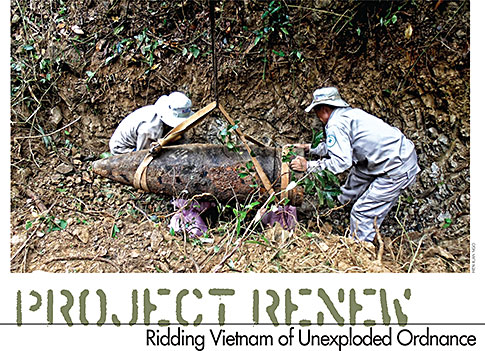
BY CHUCK SEARCY, The VVA Veteran
For most Americans, the Vietnam War ended in 1975. But for too many Vietnamese, the war didn’t end then. They continued to suffer death, injury, and lifetime disabilities from munitions that remained on the surface or just under the soil. These weapons posed a constant danger to unsuspecting residents throughout the country—but especially along the former demilitarized zone.
In 2001, when Project RENEW was launched, Quang Tri Province had been experiencing sixty to eighty accidents involving unexploded ordnance (UXO) every year since the war ended. Vietnam’s Ministry of Labor, Invalids, and Social Affairs reported that more than 100,000 Vietnamese had been killed or injured nationwide by bombs and mines.
Fifteen years later, Project RENEW’s efforts—with the cooperation of other NGOs and provincial government agencies—have paid off. In 2016 there was only one accident in Quang Tri Province.
In 2000 a delegation from the Vietnam Veterans Memorial Fund (VVMF) visited Vietnam. By the end of that trip VVMF’s leadership decided to help Vietnam recover from the consequences of the war. The government of Quang Tri Province urged VVMF to come up with a different and more effective approach to the UXO problem in the province. A decision was made to broaden and improve upon the conventional efforts already underway involving international mine action organizations and Vietnamese military units.
The government suggested that VVMF design a “comprehensive and integrated” plan to deal with bombs and mines. The focus would be on clearance and safe cleanup of ordnance, on teaching children and adults how to be safe and to protect their families and their communities, and on helping amputees and people with other disabilities caused by bomb and mine accidents.
EARLY CHALLENGES
I returned to Vietnam in January 1995 after serving in the U.S. Army as an intelligence analyst in Saigon, in 1967-68. The Vietnam Veterans of America Foundation (VVAF) had received a grant of $1 million from the U.S. Agency for International Development (USAID) to upgrade and equip a workshop at the Swedish Children’s Hospital in Hanoi. President Bobby Muller offered me the job of program manager. The mission was to improve and expand production of orthopedic braces for children with polio, cerebral palsy, and other mobility problems.
We had to rebuild and renovate a large section of the rehab department at the Children’s Hospital, install routers, band saws, ovens, and work benches, and arrange sufficient ventilation, while training Vietnamese in the fabrication of lightweight polypropylene braces designed and custom-made for disabled children.
When the workshop opened in 1996, the doctors and technicians quickly reached full capacity in treating patients, who were coming from far and wide to be examined and fitted with assistive devices. Soon the staff were treating thirty to forty patients a month, providing them with high-quality orthotic devices that enabled many of them to walk without assistance for the first time.
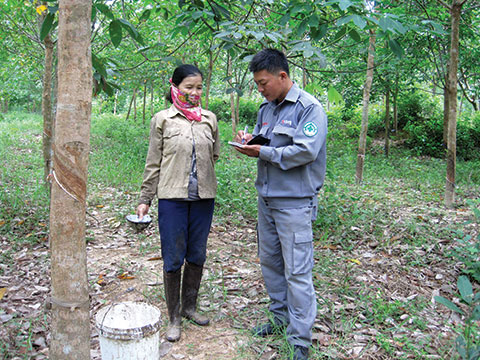 During those early years, there was discussion among my Vietnamese doctor friends and medical staff about bombs and mines and the damage such explosives were continuing to cause throughout Vietnam. We read newspaper accounts every week of accidents and casualties throughout the country. The Vietnamese military, given the job of cleaning up ordnance from the war, was inadequately equipped and insufficiently funded. Besides, it was not a priority. Many Vietnamese, including some officials, seemed to accept that this was a problem that would never go away because the challenge was overwhelming.
During those early years, there was discussion among my Vietnamese doctor friends and medical staff about bombs and mines and the damage such explosives were continuing to cause throughout Vietnam. We read newspaper accounts every week of accidents and casualties throughout the country. The Vietnamese military, given the job of cleaning up ordnance from the war, was inadequately equipped and insufficiently funded. Besides, it was not a priority. Many Vietnamese, including some officials, seemed to accept that this was a problem that would never go away because the challenge was overwhelming.
The war’s destruction was immense. I knew that unexploded ordnance, even decades later, was a lethal threat to farmers, school children, and innocent villagers going about their daily tasks. The reports were too frequent to ignore.
I also came to understand that Agent Orange was an insidious legacy of the war. American veterans were becoming painfully aware of the health consequences that seemed to be directly linked to Agent Orange exposure. But the U.S. government was in denial, and the Vietnamese government seemed reluctant to push either issue.
We asked why the U.S. was not accepting more responsibility for these legacies of war that threatened the lives of generations of Vietnamese born long after the war ended. Some members of Congress—and increasingly vocal veterans and organizations—pushed for greater U.S. involvement. One of the leading advocates was Sen. Patrick Leahy (D-Vt.). The War Victims Fund, which he helped set up and later was renamed the Leahy War Victims Fund, provided funding for humanitarian projects run by VVAF and other nonprofit organizations.
The Department of State’s Office of Humanitarian Demining showed sharper interest in the possibility of U.S. cooperation with Vietnam in cleaning up UXO contamination. Gradually, the door opened to some funding from the U.S. to Vietnam’s Ministry of Defense. Technical equipment was provided, and more funds became available for NGOs with expertise in demining and UXO mitigation.
A few NGOs in Hanoi with a shared interest in these problems formed the Landmine Working Group to explore ways to collaborate. The provincial government in Quang Tri was eager to have help in dealing with the problem.
A Seattle-based organization, PeaceTrees, had planted trees around the world in areas of former conflict, disaster, and environmental degradation. Founders Jerilyn Brusseau and Danaan Parry came to Vietnam to propose a similar project. I encouraged them to visit Quang Tri. The provincial government welcomed the idea, but noted that any tree-planting effort would first require a very careful clearance of bombs and mines in that area. That opened the door for the first U.S. involvement in the cleanup of bombs and mines: the safe clearance of six hectares of land by the Vietnamese military, funded by PeaceTrees, and followed by the planting of more than a thousand trees.
Soon afterward a German organization, SODI-Gerbera, got involved, followed by the large British demining organization, Mines Advisory Group (MAG), Clear Path International, and Golden West Humanitarian Foundation. The situation was now ripe for the introduction of the concept that became Project RENEW.
TAKING A STAND
The decision to launch Project RENEW depended on raising $500,000 to guarantee at least two years of adequate funds to make the project a reality. Jan Scruggs, VVMF’s president, convinced Christos Cotsakos, a Vietnam veteran who had been wounded in Quang Tri, to come up with half the funding. Cotsakos had been very successful with E*Trade Online Financial Services. I approached the Freeman Foundation, which matched Cotsakos’s donation with another $250,000. Project RENEW was underway.
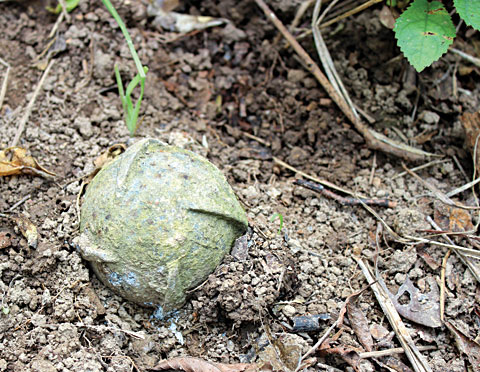 A bright young staff member, Hoang Nam, and I took the lead in establishing Project RENEW. We hired core staff, allocated some of our budget to bring in a technical expert, Bob Keeley from European Landmine Solutions, to help us structure the project and train staff, and we focused on risk education—teaching people how to be safe, to avoid accidents and injury, and to report ordnance as they found it.
A bright young staff member, Hoang Nam, and I took the lead in establishing Project RENEW. We hired core staff, allocated some of our budget to bring in a technical expert, Bob Keeley from European Landmine Solutions, to help us structure the project and train staff, and we focused on risk education—teaching people how to be safe, to avoid accidents and injury, and to report ordnance as they found it.
We soon learned that without trained personnel to safely destroy or remove dangerous ordnance when calls for help came in, our effort was quickly losing credibility with local people. We had to intensify our efforts to raise funds to deploy Explosive Ordnance Disposal (EOD) teams to answer urgent calls for help.
Project RENEW struggled for funding, from sources ranging from the U.S. Department of State to the Norwegian government, which became one of Project RENEW’s strongest assets.
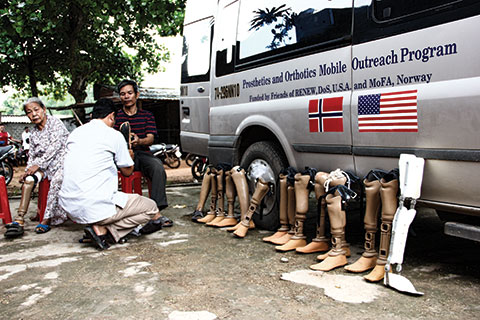 In 2008 a team from Norwegian People’s Aid (NPA) came to Quang Tri, looking to expand into Vietnam with its impressive global mine work, and entered into a partnership with Project RENEW. The Norwegian government provided substantial funding and critical technical support. This was at a time when the future of Project RENEW was uncertain because of a decision by VVMF in 2011 to pull out of the ten-year partnership. VVMF wanted to focus on its $100 million Education Center.
In 2008 a team from Norwegian People’s Aid (NPA) came to Quang Tri, looking to expand into Vietnam with its impressive global mine work, and entered into a partnership with Project RENEW. The Norwegian government provided substantial funding and critical technical support. This was at a time when the future of Project RENEW was uncertain because of a decision by VVMF in 2011 to pull out of the ten-year partnership. VVMF wanted to focus on its $100 million Education Center.
The Norwegian funding was crucial. Soon afterward, the State Department pledged additional funds, through NPA, with complementary funding to Mines Advisory Group and PeaceTrees. Project RENEW and NPA received $7.8 million for a three-year period. MAG received more than $8 million.
We are now following a plan developed by NPA’s country director at the time, Jonathon Guthrie, which is an evidence-based Cluster Munitions Remnants Survey (CMRS). That initiative combines surveying of UXO-contaminated areas, interviewing local residents, comparing bombing records turned over by the Department of Defense, and using that data to deploy teams that remove or destroy ordnance in those areas. As the footprints of cluster munitions strikes are reduced and eliminated, and all other ordnance in the area neutralized, this evidence-based information goes into a comprehensive database available to all who need the information.
THE CURRENT SITUATION
There is broad cooperation in Quang Tri Province among all key actors, including NGOs as well as the Vietnamese military. That level of cooperation is unprecedented and is a positive indicator that we are moving toward the date, in a few short years, when the problem will be managed and can be turned over completely to the Vietnamese. The U.S. can then claim, with some truth and satisfaction, that we finally did the right thing.
The shift in strategic thinking has been slow and difficult. At Project RENEW we believe that it is impossible to clean up every bomb and mine. The U.S. dropped at least 8 million tons of ordnance during the war, of which the Pentagon has said about 10 percent did not detonate. That’s a massive amount of ordnance still in the ground—impossible to clean up in a generation.
However, it is possible to make Vietnam safe. We are demonstrating that every day in Quang Tri Province. A combination of trained, equipped, professional clearance and EOD teams, a reliable database, and an educated and aware local population can keep everyone safe.
It is being done in Germany and other European countries, which still clean up thousands of bombs every year from World War I and World War II. In Quang Tri Province, going back to 1996, Project RENEW and other NGOs have destroyed more than 600,000 bombs. Last year EOD teams managed by Project RENEW and NPA conducted 723 spot tasks in response to call-ins from local people, resulting in 2,383 items of UXO being destroyed. Altogether, more than 18,000 items were found and destroyed during survey and quick response to UXO callouts. Of those, 61 percent were cluster munitions.
THE AGENT ORANGE ISSUE
The other painful legacy of the war in Vietnam is Agent Orange. The Vietnamese still have not come close to any meaningful assistance in dealing with horrendous medical, health, and rehabilitation challenges that are attributed to dioxin poisoning.
The U.S. government is spending more than $100 million to clean up the dioxin contamination at the Da Nang International Airport, and there are indications that the former airbase at Bien Hoa may be next, with a higher price tag.
But other than some expansion of funding for disability assistance in Vietnam, there has been little or no U.S. funding to help families suffering with two, three, or more severely disabled children, now in their twenties or thirties, whose physical and cognitive deficiencies are so serious that they can do nothing for themselves.
With sponsorship from Veterans for Peace (VFP), Project RENEW tried to get funding from USAID to reach out to 15,000 Agent Orange victims in Quang Tri Province. That proposal was rejected. RENEW staff have not made a decision about whether to again seek U.S. government support for these families.
People ask me, after all these years, why are you still here? I’m not needed, really; the Vietnamese staff of more than 180 Project RENEW and NPA personnel are far more capable than I will ever be.
However, if I can make a small contribution to keep the effort on track, helping us focus on the eventual outcome of making all of Vietnam safe, then I’m committed to that mission. The Quang Tri model is working. If I can help keep the constructive and mutually respectful channels of communication open among American veterans, Vietnamese veterans, Vietnamese government officials, and U.S. Embassy staff and Washington officials, then I’m happy to try to help for a while longer.
It will not be many more years, I’m convinced, until we can put an end to all the tragedy, pain, and sorrow of the past. Then Vietnamese can live with confidence and go about their daily tasks without fear of bombs and mines. They will know that they are managing the situation in the best way possible. And American veterans can say we helped bring a final end to the war in Vietnam.
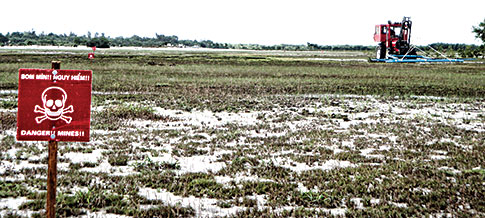









2 Responses
Are there cluster bomb activities in the danang area? I will be visiting next year and have an interest in helping people in this area. My dead husband was there in 68 and 69
Looking for volunteer opportunities in danang